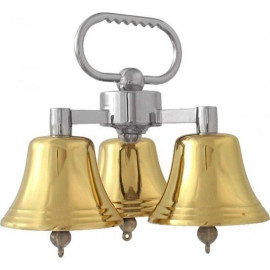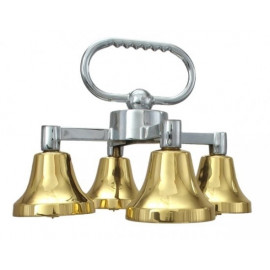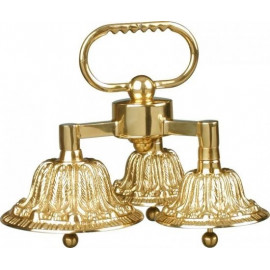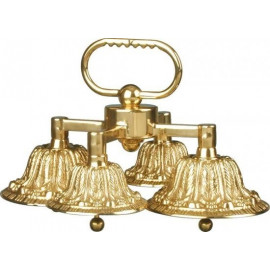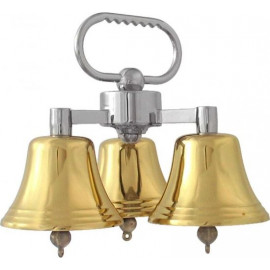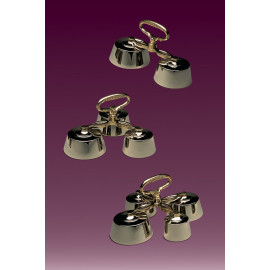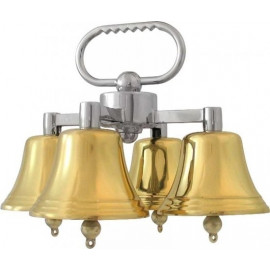No products
Product successfully added to your shopping cart
There are 0 items in your cart. There is 1 item in your cart.
Altar Bell and Gong
- Altar Bell and Gong
- Candle Snuffer
- Candlestick
- Catholic Pyx
- Chalices
- Church wall lamps
- Ciborium
- Crosses and Crucifix
- Cruets & Trays
- Holy Water Font
- Holy Water Pot
- Missal Stand
- Monstrance Tabor
- Monstrances
- Offering Baskets
- Oil Stock
- Patens
- Reliquaries
- Sanctuary Bells
- Sanctuary Lamp
- Sprinkler
- Thurible, Boat, & Spoon
- Travel Liturgy & Mass Kit
An altar bell is a small hand-held bell or set of bells used in the Roman Rite of the Catholic Church, Lutheranism, Methodism, and Anglicanism. The primary reason for the use of such bells is to create a “joyful noise to the Lord” as a way to signify the Real Presence of Christ in the sacred Elements. Altar bells are rung at certain times during Mass, such as during the Sanctus and Elevation, to draw attention to the precise moment of the consecration. The ringing of an altar bell began probably in the 13th century and was not introduced into papal Masses until the reign of Pope John Paul II. Altar bells are not rung from the end of the Gloria in excelsis at the Mass of the Lord's Supper on Maundy Thursday until it is sung again at the Easter Vigil on Holy Saturday. During this holiest season of the liturgical year, known as the Paschal Triduum, a wooden clapper known as a crotalus is sometimes used to make important sounds in place of the altar bell. The correct type of bell to be used at the altar is a small, single-tongued hand bell held in a balanced position.
An altar bell is a small hand-held bell or set of bells used in the Roman Rite of the Catholic Church, Lutheranism, Methodism, and Anglicanism. The primary reason for the use of such bells is to create a “joyful noise to the Lord” as a way to signify the Real Presence of Christ in the sacred Elements. Altar bells are rung at certain times during Mass, such as during the Sanctus and Elevation, to draw attention to the precise moment of the consecration. The ringing of an altar bell began probably in the 13th century and was not introduced into papal Masses until the reign of Pope John Paul II. Altar bells are not rung from the end of the Gloria in excelsis at the Mass of the Lord's Supper on Maundy Thursday until it is sung again at the Easter Vigil on Holy Saturday. During this holiest season of the liturgical year, known as the Paschal Triduum, a wooden clapper known as a crotalus is sometimes used to make important sounds in place of the altar bell. The correct type of bell to be used at the altar is a small, single-tongued hand bell held in a balanced position.
Altar Bell and Gong There are 40 products.
The Enchanting World of the Church Altar Bell
The church altar bell, a small yet profoundly significant artifact, carries with it centuries of tradition and spiritual significance. Its gentle ring pierces the air, calling the faithful to a moment of reverence and signaling the presence of the divine. Let's dive into the captivating history, purpose, and modern-day use of this cherished instrument.
A Brief History of the Church Altar Bell
The origins of the church altar bell trace back to the late 12th century, a time when the practice of elevating the consecrated Host was introduced. Initially, the belfry's large bell was rung to alert those outside the church, allowing them to pause and adore from afar. Over time, this evolved into the use of a smaller bell at the altar, specifically to signal those within the church of the sacred moments during Mass.
Interestingly, the use of bells in a religious context predates Christianity. Bells were used in various ancient cultures to ward off evil spirits or to call the community to gather. In the Christian tradition, the bell's role became more defined with the introduction of the Mass, becoming an integral part of the liturgical celebration.
The Purpose and Significance
The primary purpose of the church altar bell is to create a "joyful noise unto the Lord," a biblical injunction that finds expression in the ringing of these sacred bells. Beyond this joyous declaration, the bell serves to focus the attention of the congregation on the most solemn parts of the Mass, particularly the consecration of the bread and wine.
The ringing of the altar bell also has a catechetical function, teaching the faithful about the significance of the Mass's different parts. For instance, the ringing of the Sanctus signals the start of the Eucharistic Prayer, the heart of the Mass, where bread and wine become the Body and Blood of Christ.
Modern-Day Use and Variations
Today, the use of the church altar bell varies widely among Christian denominations and individual parishes. In some places, the tradition remains strong, with bells ringing at key moments of the Mass. In others, the practice has faded, perhaps due to changes in liturgical emphasis or simply evolving traditions.
The design and number of bells used can also vary. Some churches use a single bell, while others employ a set of bells, each with a distinct tone. The method of ringing the bell(s) can differ as well, with some traditions specifying the number of rings for each part of the Mass.
FAQs
Why is the church altar bell rung during Mass?
The church altar bell is rung to signal the faithful of significant moments during the Mass, particularly the consecration, helping to focus their attention on the mystery of transubstantiation.
Is the use of the church altar bell restricted to the Catholic Church?
No, while most commonly associated with the Roman Catholic Church, the use of altar bells is also found in Anglicanism, Lutheranism, and Methodism, among other Christian denominations.
Can any bell be used as a church altar bell?
While technically any bell could be used, traditionally, church altar bells are specifically designed for the purpose, often crafted from bronze or brass and blessed before use.
Has the significance of the church altar bell changed over time?
While the core significance of the church altar bell as a call to reverence and attention during Mass has remained constant, its use and the understanding of its importance may vary across different cultures and periods.
In Conclusion
The church altar bell, with its rich history and deep spiritual significance, continues to be a cherished part of Christian liturgical practices. Whether signaling the miraculous moment of consecration or calling the faithful to prayer, its clear, resonant ring is a reminder of the sacred, a bridge between heaven and earth. As traditions evolve and practices vary, the enduring appeal of the church altar bell speaks to its profound ability to touch hearts and focus minds on the divine mystery at the heart of Christian worship.

